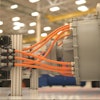FRANKFORT, Ky. (AP) — When Steve Mims looks at an outdated and unused wastewater treatment plant, he envisions a bustling - and profitable - fish farm.
The Kentucky State University researcher and his colleagues will spend the next three years trying to turn Winchester's former plant into a "model farm" full of paddlefish, hybrid striped bass and channel catfish.
If all goes according to plan, Mims believes the farm, currently rented out by a private business owner, could generate $250,000 a year in sales and create jobs.
That's a far cry from the hundreds of thousands of dollars Mims says the City of Winchester would have spent to demolish the facility.
"Every community has a wastewater treatment plant, and there are a lot of plants now that are having to build larger, newer facilities, and that leaves behind these older facilities," said Mims, an aquaculture professor at KSU.
"Our idea is that we need tanks, and we need infrastructure - like electric - that are already there to grow fish."
Mims and his colleagues in the College of Agriculture, Food Science and Sustainable Systems have been studying this kind of reuse project since 2006, but they just landed their biggest grant to date.
KSU received $599,751 last month from the United States Department of Agriculture's National Institute of Food and Agriculture.
That funding will allow the researchers to focus on the Winchester project for three years, studying the ins and outs of turning a former wastewater treatment plant into a working aquaculture farm.
Winchester Municipal Utilities owns the property, but began leasing it to Tim Parrott of Aquila International Inc. about a year and a half ago. KSU will help Parrott bring the facility up to "best practices" level, using the experience to inspire a how-to manual for prospective farmers.
"It's a true partnership with city municipality, a private company and a university," Mims said.
Researchers will also take tissue samples from fish to monitor for contaminants, figuring out which water treatment methods result in the cleanest fish, and even if certain species are safer to eat than others.
They will host workshops and field trips and write an online course about the theory and applications for reclaimed water. They will also experiment with growing tomatoes and peppers in the solids that remain after water is purified, a substance that some cities already give to farmers as fertilizer.
The researchers are doing similar projects at wastewater treatment facilities in Frankfort and London, and they hope to expand to other plants that now sit idle. Seven others are interested, he said, but funding is uncertain.
Most new treatment facilities are built right next to the old ones, allowing farmers to use the reclaimed water for aquaculture, Mims said. The tanks don't generate waste because the water cycles right back to the treatment plant.
The big idea is to establish regional fish hatcheries through public-private partnerships, with the young "fingerlings" being sold to local farmers to be raised in their own ponds, Mims said.
"If we can show communities that this is useful, and they begin to use them in their communities, then we can get aquaculture to grow in this state," he said.
Frankfort's sewage treatment plant off Kentucky Avenue is now home to thousands of hybrid striped bass that will be moved to the Winchester facility in a few months.
Mims checked on the fish Thursday with Rafael Cuevas, a researcher who wrote much of the USDA grant application. A 30,000-gallon tank that sat unused since the 1950s serves as a temporary habitat for the young fish.
Mims acknowledges that some people might recoil at the idea of eating fish farmed in a former sewage treatment plant. But so far his research shows that the fish are safe for human consumption.
Levels of heavy metals, pesticides and other substances fall "well below" FDA limits, he said, and are similar to those found in chicken or beef. And those things are also found in wild-caught fish, he said - sometimes at even higher levels.
People are, in effect, drinking purified wastewater anyway.
Mims said that after wastewater is cleaned at the sewage treatment plant, it's dumped into the Kentucky River - the same place drinking water comes from, though it's cleaned again before it comes through the kitchen tap.
Some cities out west have started turning wastewater into drinking water directly, without the extra costly step of dumping it first, Mims said. Residents are unhappy at first, he said, but their much-lower water bills often change their minds.
"There are only a few extra steps, and it would save communities a whole lot of money, but it's a psychological issue," he said.
"Drinking wastewater is what people think, but they don't think anything about drinking water out of the river. It's a concept that we're trying to work on, first by using fish."






















